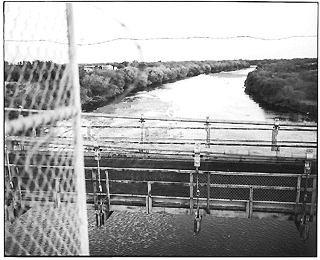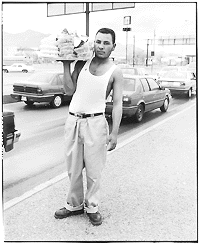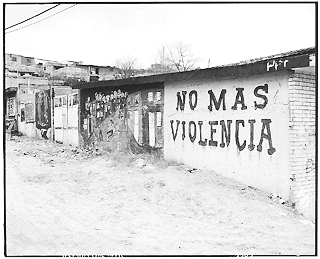Framing the Border
Photography of the Region Between Mexico and the U.S.
By Rebecca S. Cohen, Fri., May 1, 1998
|
photograph by Byron Brauchli |
Snapshot of a moment in the cultural life of Central Texas. On a sunny Thursday morning in a gallery in Austin's Uptown Cultural District, a handful of people who all share a passion for photography and for the region encompassing Mexico and the southwestern United States gather round a table for a conversation. The group is a mix of types ñ several curators, a couple of gallery directors, a photographer, some new to the area, some longtime fixtures ñ but they represent a noteworthy convergence of interests and experiences that, in 1998, are making Central Texas an increasingly important center for the collection, study, and display of photography of Texas and Mexico. Around the table are: Gil Cardenas, owner of Galeria Sin Fronteras, the gallery in which the conversation is taking place, and teacher at the University of Texas; Elizabeth Ferrer, new director of the Austin Museum of Art, scholar in 20th-century Mexican photography, and author of A Shadow Born of Earth: New Photography in Mexico; Roberto Tejeda, assistant curator of the Wittliff Collection of Southwestern and Mexican Photography; Sylvia Orozco, director of Mexic-Arte Museum; Arthur Palacios, director of Galeria Sin Fronteras; and Byron Brauchli, local photographer whose exhibition "Cultural Refractions: Border Life en la tierra de nadie," is currently on display at Galeria Sin Fronteras. Chronicle arts writer Rebecca Cohen conducted this round table interview to learn something about the photography of this region and what we should know about it. ñ Robert Faires
|
photograph by Byron Brauchli |
Roberto Tejeda: I think there is a difference, and I think it does matter. That's what gives photography that X-factor, which is neither one nor the other; it's a third space. Photography, by its very nature, is going to be a document. The result that is the image is basically the photographer saying, "This is worth seeing." It also moves into a realm of activity, which is what makes it such a peculiar form of expression. Much of photography lies in what we don't see, which is what I mean by activity, that is, the end results of the images are the visual and the material form that we see. What it is actually about will be contained in what's going on, but also in what is not contained in that experience.
Elizabeth Ferrer: I tend to agree that the use of the word "documentary" is very problematic. Each of these works is so interpretive and also so open to interpretation. That is where one leaves the realm of straight photographing, as defined by a newspaper taking a picture of a certain event, to simply somebody with their own eyes using a camera and perhaps other means ñ in Byron's case, it's platinum printing, which adds its own distinctive layer onto the photograph. So there's a lot of interpretation and expression going on.
Gil Cardenas: I would agree as well. To a large extent, the determination to classify work as documentary or not is pretty much in the intention of the photographer. The photographer's intent could be research or photojournalism, or it could be purely documentary. But even if his intention is documentary, there can still be an aesthetic and artistic value to it depending on how the artist approaches the shooting. Often that makes a real big difference in the end. The other side of it is that there is an inherent documentary value in the work irrespective of the intent of the photographer.
Sylvia Orozco: In time the photograph becomes a document. When you look at it 50 years from now, you're looking at what was there 50 years ago.
Ferrer: John Berger said that every photograph is an ideological choice. Certainly these photographs are an ideological choice of Byron's. First, the choice to do the photographs in this part of the world is itself a statement. To make the images that he made there and present them is a statement about the way he sees that world and I think something about the artist.
Cardenas: One simplistic distinction between documentary and aesthetic work is the aesthetic approach has no interest in documentation; there's no interest in having that image represent truth in any sense. You can manipulate it, you can retouch it, you can misrepresent it, because your intention is not necessarily to represent. That's not your goal. In documentary work, by intention, you approach it from some attempt to be objective and truthful, even though you may not achieve it.
|
photograph by Byron Brauchli |
AC:Of course, we could get into, what is truth?
Cardenas: It's all relative and all ideological.
AC:Byron, can you say why you were drawn to photograph the border?
Brauchli: It's interesting. One earlier series of photographic work of mine is from central Mexico, from Veracruz, where I lived for a number of years. In years past, when I was living in Austin and would travel south over the summer for photographs of Veracruz, the border was a region which I selectively edited out of my experience by just passing over it. I understood that it wasn't really Mexico but that it wasn't the United States either, and it was only over numerous trips down that the sort of eccentric qualities of the border really started to sink in, and I became more and more fascinated with the region, precisely because it wasn't Mexico and it wasn't the United States. It had a sort of cultural autonomy of its own that grabbed my attention. Also, work I had been doing on a landscape series in Veracruz dealt with a crossroads at which Mexico found itself in terms of economic development versus environmental and preservation kinds of issues, and these same issues are even more salient along the border of the U.S. and Mexico. Hence, it was a natural extension to repeat that sort of work, which was even more exacerbated by the border. That's basically what drew me to it.
AC:Are there particular emotions or images that you expect of photography of the Southwest, as opposed to photographs of places that have less of a sense of region?
Orozco: The fact that there's an indigenous culture. I think in that one photograph of Byron's where you see a group of Indians sitting there on the side of the street and there's cars passing by on the bridge ñ it's urban versus rural, indigenous versus foreign. Those are very strong concepts.
AC:How about the issue of religion? The Virgin appears in two-thirds of these photographs. Is that likely to be the case elsewhere? What is the role of Christian and Catholic symbolism in all of this?
|
photograph by Byron Brauchli |
Tejeda: Also, in addition to being a religious symbol, the Virgin of Guadalupe is a highly politicized symbol, one used in the 18th and 19th centuries as an emblem of mixed lineage, and used by the Mexican state in the 20th century to create a national myth ñ and a cohesive myth ñ which I think reverberates in collaboration with any kind of photographic level.
Ferrer: And today she's also a popular symbol. One of the things that photography can do is capture all these ruptures and alterations and juxtapositions in the culture, and that's something that I see in photography from the Southwest and along the border.
Cardenas: And you're not likely to see the same thing on the northern border. I don't think it's captured the imagination of photographers. That's not to say it's not been photographed. I really don't know that there's a body of work that's looked at the U.S.-Canada border as much as the U.S.-Mexico border. There are a lot of things that have captured the imagination of photographers in Mexico and the Southwest that are different from what you would find in other places. Maybe that's what unique about it: its difference.
AC:The sort of foreign flavor. Exotic?
Cardenas:For some, foreign; for others, indigenous. For anybody looking at it in terms of the region, there's a telltale history that predates the U.S. formation. It's Mexico. It's still Mexico.
Orozco: And there's a strong contrast in all the differences. It's also about restrictions, like these fences... all these barriers that have to do with two political forces or people or countries or cultures trying to prohibit them from combining, from mixing, from living together.
|
photograph by Byron Brauchli |
Arthur Palacios: I think that's one of the most interesting things about it. All these barriers and fences and the waterway are built up and built up, but there's still that very, very complex weaving of two cultures. When you cross over, you see everything that's trying to stop you from crossing over physically.
Cardenas: The interaction is very intense.
Orozco: Well, it's very intimate because it's in us. We're Mexican-Americans. We're the epitome of it because we're the mixture. We're speaking English and Spanish. We're both cultures at once, so we ourselves are a symbol of that intermixing, that contrast.
Cardenas: Along the same lines, for people who live on the border, even if they're not Mexican, they also have real attachments in the same ways as residents. A lot of people in South Texas, for example, who aren't Mexican speak Spanish, and their children speak Spanish. They grew up in that environment and so they have a sympathetic connection and attachment to the border region.
AC:So you can make a choice to be bi-cultural.
Cardenas: Some people do. A lot of people don't. Some people reject it. Outright.
AC: Is it somehow discernible when the photographer is Mexican, Hispanic, or Anglo? Whether the photographer has grown up south or north of the border? Do you look for it, do you pick it up, are you sensitive to it?
Ferrer: It's problematic.
Tejeda: It's a real problematic issue. In the world we live in there's so much exile and migration, border crossing, flux, et cetera, that, yes, it's clearly of interest and it has to do with the content of the resulting image, but it is problematic.
Ferrer: There are certainly times when I have seen photographic work, typically by someone from the United States traveling in Mexico, and their photographs are suffused with an interest in the exotic or the nostalgic.
Tejeda: And yet even those "Orientalisms" can ñ and I stress the word "can" ñ can be of interest. Which just complicates the issue further, as if it weren't complicated enough.
Ferrer: I don't think it's invalid. Some curators or critics will be upset when the person photographing is not from the same country, but I contend that you always learn from a source. I think you always cross over. Sometimes it's not such a great leap and sometimes it is a great leap, and any of those practices can be valid.
|
photograph by Byron Brauchli |
Cardenas: I'm reminded of Dorothea Lange's notion that the closer you get, the better. Obviously, that doesn't apply to everything, but especially in documentary work I think it's important. I think there is some advantage ñ not an inherent advantage, but there is some advantage ñ to growing up and knowing an area very intimately, on a day-to-day, extended and sustained basis. So that if you have people of equivalent experience and technical know-how, one for one, there is added value in someone who knows the little corners and knows people to get inside their homes on a repeated basis. So they could shoot and capture something that's unknown to the outsider.
AC:Byron, has it been problematic for you?
Brauchli: The travel to the border and the fact that I'm not from the region? Yeah, in a sense. I mean, if you're not there all the time, like Gil says, you're not there for all the sunsets and sunrises and spectacular lighting situations, and to get to know a family. For me, what's been useful is my knowledge of the culture, the years I've spent in Mexico and familiarity with both the border region and the interior.
Cardenas: Facility with language, too.
Brauchli: Facility with language definitely breaks down barriers which may exist. Generally, before I even start photographing, I take my camera from behind my back
or wherever it is, I strike up a conversation to relax the individual that I'd like to photograph. One for one, as Gil was saying, the person who knows a place has an advantage. That actually cuts two ways, come to think for it, because you become desensitized looking at certain things, you start to take things for granted and maybe miss them as subjects for photographs. We had a long discussion about this in these workshops on border landscape photography that I collaborated on with two groups of Mexican photographers. There's this image on a diptych of this bridge that's not running across the border or anything, it's just a big, busy avenue in Tijuana, and it's above the studio of the fellow who coordinated the workshops. I think that it was something that was simply so quotidian to him, so familiar, he probably never even dreamed of taking its picture. And yet, I think it's a good image. So, it really cuts both ways.
AC:I sense a new interest in collecting among several institutions in the Central Texas area. Why collect photographs of the region?
|
photograph by Byron Brauchli |
Tejeda: I think what's been discussed here is the specificity of place, and since we are living here and there's this spill-over, we can discuss certain geographies, we can discuss other forms of addressing place. That's why certain images that might be generally or loosely labeled of the Southwest or of this other space that's been created between Mexico and this part of the United States deserve interest.
Cardenas: And there's rapid change as well. That's what photography does, is capture that, whether it's approached from the aesthetic or the documentary or some combined interest. What you see sometimes in the border, even a crossing point can change in a year. There'll be new barriers, new structures, new lights. Some of the things that just popped up in a situation ñ a mural ñ might be here today but gone tomorrow... another thing might be in its place, or it could be defaced. And so that's one of the advantages of photographing it on a repeated basis, to see changing environment, changing landscape, changing kinds of interaction. Byron's approach to it hits at that question of modernity and contrast.
Brauchli: The rural versus the modern, which I think Sylvia very eloquently noted in the photograph of the Indians right next to the bridge crossing into Tijuana. It becomes a very interesting entwining of those two aspects of life.
AC:Does the presence of the Center for Mexican American Studies make Austin more of a center for the study of Southwestern art, Southwestern culture, issues related to the border?
|
photograph by Byron Brauchli |
Cardenas: Sure. The Center for Mexican American Studies helps push the agenda in that direction for research and scholarship and activities. The Institute for Latin American Studies also does the same thing. The LBJ School of Public Affairs has an interest in border studies, as do our centers. We take questions about migration and demography so there's a lot of synergy in this area, a lot of knowledge is produced through research and discussion and interpretation. We also have an express interest in collecting more work in this area.
AC:Liz, you said that the Austin Museum of Art is interested in collecting photography. Do you have a vision for a specific kind of photography?
Ferrer: Well, in thinking about how the museum would collect, photography just seemed a natural to me for a number of reasons. It just seems that a lot of people are interested in it in terms of building a collection. The practical part is less expensive than painting although we also plan to collect books and all kinds of media. And it's an area that I have a passion for and some knowledge of, so all those factors kind of fitted in. Our mission, in terms of geographic scope, is the United States, Mexico, and the Caribbean. So I feel that in collecting we can also talk about this other region that's not only Mexico and not only the United States but also the border, and regional issues that are so important to us.
AC:The next show at the Wittliff Gallery.....
Tejeda: The next show is photographs by Mariana Yampolsky, images of Mexico. I'd say she's one of the leading Mexican photographers of her kind, in documentary and regional photography. For those who are not familiar with her images, they're in sort of three zones: the vernacular and architecture of Mexico, rural peoples, and their celebrations.
AC:What other photographers should people look for if they're looking for really fine photography of the Southwest?
Cardenas: Miguel Gander, out of New Mexico, is one of the artists I think about. He was from Mexico, but he's also photographed the border.
|
photograph by Byron Brauchli |
Tejeda: Eniac Martinez. One of his photographs is going to follow several families from Oaxaca to Los Angeles or Southern California, and that migration obviously includes the border. His images always have an unusual approach. There's a picture of a young girl in a Halloween costume ñ it's in Elizabeth's book, as a matter of fact. It emits a very disturbing aura, as does much of his work.
Ferrer: There are some interesting artists who do a lot of traveling back and forth. One is Ruben Ortiz ñ most of his works are color, really sort of jarring, very pop images, things that he sees at the border, dealing with a lot of pop culture images.
Cardenas: There are some real contemporary folks who are working in the documentary vein: Alan Pogue, who's done images of the South Texas border; Ken Light, in California, who's done a lot of work in migration, people crossing; Don Bartalente.
I think there are also some photographers who photographed the border and have since passed away who are waiting to be re-discovered. Luis Bernard, for example, out of Arizona. Smithers, whose work is in the Harry Ransom Center collection, is a photographer who was hired by the first Border Patrol established in Texas. They didn't have a category for a photographer, so they hired him as a cook. I remember looking through the collection and found a photograph of the first Texas Border Patrol, all mounted on horses, and on the back Smithers documented each of the names. Every single one of them were former Texas Rangers. Tells you a lot about the first Border Patrol. That's the only place you would ever find that information. He photographed people, different kinds of things going around with the Border Patrol, as well as landscapes. People like that are
waiting to come into their own, or they've been somehow recognized before but have been forgotten.
| photographs by Byron Brauchli
| |
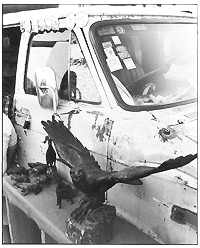 |  |
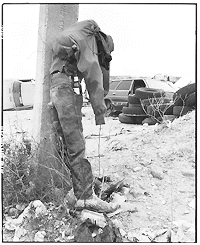 |  |
"Cultural Refractions: Border Life en la tierra de nadie," photographs by Byron Brauchli, is on view at Galeria Sin Fronteras, 1701 Guadalupe, through May 21. Call 478-9448 for info.





